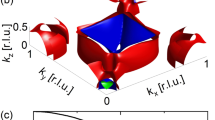Abstract
The concept of an optimal electron–phonon interaction spectral density as an Einstein spectrum which allows to describe all physical properties of a superconductor in an optimal way is developed from Carbotte's original definition of an optimum spectrum. It is shown, using the borocarbides YNi2B2C and LuNi2B2C as examples, that such a concept is meaning ful even for anisotropic systems. An Einstein spectrum is sufficient for clean-limit systems, a 2δ-peak spectrum is better suited for anisotropic systems with impurities.
Similar content being viewed by others
REFERENCES
G. M. Eliashberg, Sov. Phys. JETP 11, 696 (1960).
W. L. McMillan and J. M. Rowell, Phys. Rev. Lett. 14, 108 (1965).
J. P. Carbotte, Rev. Mod. Phys. 62, 1027 (1990).
C. R. Leavens, Solid State Commun. 17, 1499 (1975).
B. Mitrovi? and J. P. Carbotte, Solid State Commun. 40, 249 (1981).
S. Manalo, Diploma thesis, Technische Universität Wien, Karlsplatz 13, 1040 Wien, Austria (1999) unpulished; S. Manalo, H. Michor, M. El-Hagary, G. Hilscher, and E. Schachinger, Phys. Rev. B (in print) and cond-mat/9911305.
F. Gompf, W. Reichardt, H. Schober, B. Renker, and M. Buchgeister, Phys. Rev. B 55, 9058 (1997)
W. Weber, Universität Dortmund, Institut für Theoretische Physik II, Otto-Hahn-Str. 4, D-44221 Dortmund (unpublished).
Shi Li et al., Int. J. Mod. Phys. 13, 3725 (1999).
M. Prohammer and E. Schachinger, Phys. Rev. B 36, 8353 (1987).
V. Shulga, S.-L. Drechsler, G. Fuchs, k.-H. Müller, K. Winzer, M. Heinecke, and K. Krug, Phys. Rev. Lett. 80, 1730 (1998).
R. S. Gonnelli, A. Morello, G. A. Ummarino, V. A. Stepanov, G. Behr, G. Graw, V. Shulga, and S.-L. Drechsler, cond-mat/0007033 (unbublished).
E. Langmann, Phys. Rev. B 46, 9104 (1992).
W. Pitscheneder and E. Schachinger, Phys. Rev. B 47, 3300 (1993).
D. Markovitz and L. P. Kadanoff, Phys. Rev. 131, 563 (1963).
J. M. Daams and J. P. Carbotte, J. Low Temp. Phys. 43, 263 (1981).
J. Bardeen and M. Stephen, Phys. Rev. 136, 1485 (1964).
A. Junod, T. Jarlborg, and J. Muller, Phys. Rev. B 27, 1568 (1983).
H. Michor, T. Holubar, C. Dusek, and G. Hilscher, Phys. Rev. B 52, 16165 (1995).
F. Bommeli, L. Degiorgi, P. Wachter, B. K. Cho, P. C. Canfield, R. Chau, and M. B. Maple, Phys. Rev. Lett. 78, 547 (1997).
H. W. Weber, E. Seidl, C. Laa, E. Schachinger, M. Prohammer, A. Junod, and D. Eckert, Phys. Rev. B 44, 7585 (1991).
N. R. Werthammer, E. Helfand, and P. C. Hohenberg, Phys. Rev. 147, 295 (1966).
F. Marsiglio, M. Schossmann, E. Schachinger, and J. P. Carbotte, Phys. Rev. B 35, 3226 (1987).
Author information
Authors and Affiliations
Rights and permissions
About this article
Cite this article
Manalo, S., Schachinger, E. Optimal Spectrum for the Borocarbides YNi2B2C and LuNi2B2C. Journal of Low Temperature Physics 123, 149–163 (2001). https://doi.org/10.1023/A:1017588310992
Issue Date:
DOI: https://doi.org/10.1023/A:1017588310992




